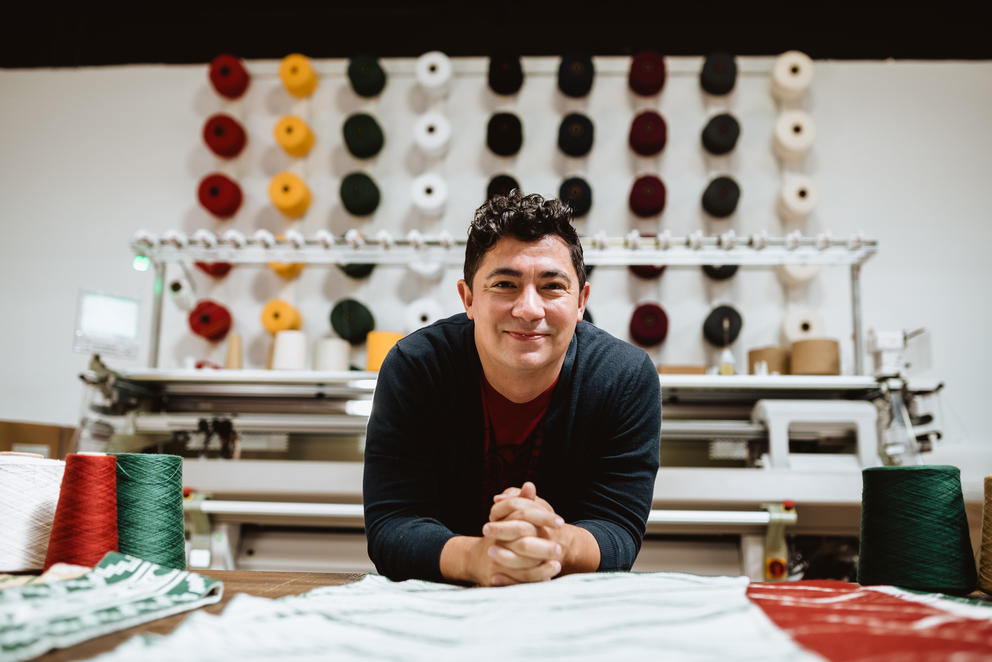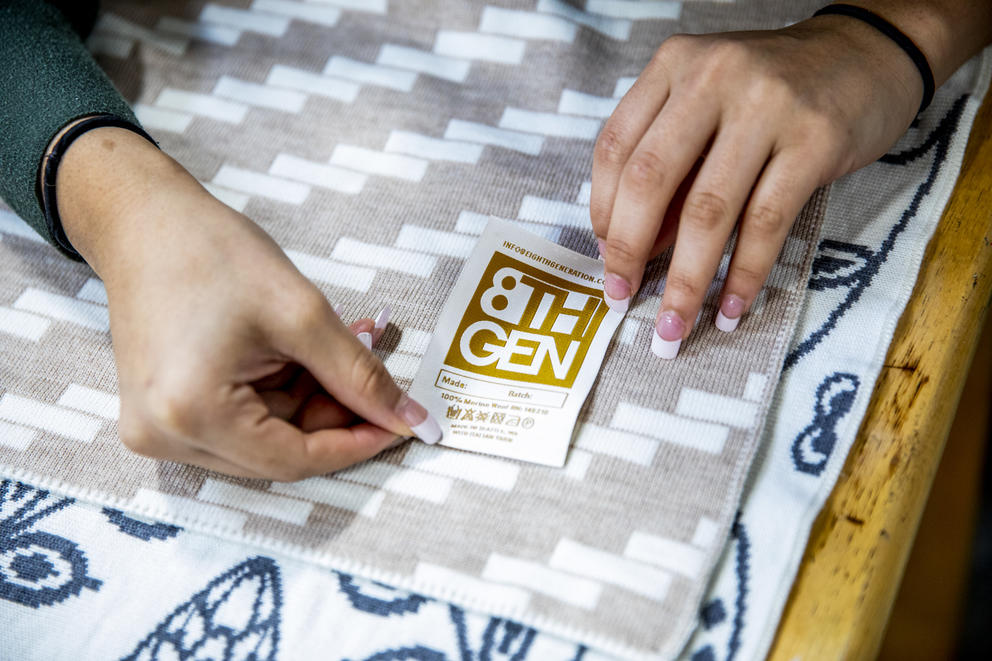The animals are all heading in the same direction, emerging from the 10-foot-wide industrial machine that is knitting them into a blue-and-white baby blanket. Inch by inch, the merino wool fabric emerges from the belly of the appliance — like a jumbo printer, but for sewing.
The blanket was designed by renowned artist John Isaiah Pepion (Blackfeet) for Eighth Generation, the Seattle-based design and lifestyle company that collaborates exclusively with Native American artists. Called “Protection,” the artwork represents the shielding powers of sacred animals.
The motif is also an apt metaphor for the Native-owned company’s latest leap forward: fabricating blankets designed by Native artists in a hyper-local warehouse with proprietary equipment.
“We’re not an emerging business anymore,” says Eighth Generation founder and CEO Louie Gong (Nooksack). “We’re going to be an emerging global player.”
Gong, a clean-cut guy with a friendly demeanor and an artist in his own right, has been the face of the company for more than a decade. He bootstrapped Eighth Generation in 2008 by custom-painting Vans and Converse sneakers with Coast Salish designs, which eventually grew into a Pike Place Market shop and national brand. While he sold the company to the Snoqualmie Tribe in 2019, he’s still its driving force. He dreams big.
For years, Eighth Generation has been selling woolen blankets (including custom designs for various tribes) from its webshop and popular Pike Place Market store. But these are produced in other factories in the U.S. and China, not in-house. Since launching its “Urban Manufacturing Initiative,” late last year, Eighth Generation has sold about 500 baby blankets and scarves made in Seattle, Gong says. He plans to start production on larger blankets later this year.
“Our investment in our own manufacturing is our effort to position ourselves to compete with much larger companies,” Gong says.
The U.S. textile industry has shrunk significantly over the past decades. There are just a few hundred mills left in the U.S. Very few of those are owned by Native American people — let alone tribes.
That’s in part why the Snoqualmie Tribe’s 2019 acquisition of the Eighth Generation store and brand was both an unprecedented business move and a symbolic benchmark. “It’s huge for us. It’s right in line with what we’re trying to accomplish: protect our culture, promote our artists and expand our tribal voice,” Christopher Castleberry, tribal council treasurer of the Snoqualmie Tribe, told Crosscut at the time. Manufacturing Native-designed woolen goods in Seattle is an extension of that strategy.
On a recent factory visit, a few blankets lie flat on an elegant wooden table. In one, small white squares radiate from the center on a field of beige. It was designed by fiber artist SiSeeNaxAlt (Muckleshoot/Chehalis), also known as Gail White Eagle. She’s in the warehouse working on a new scarf design.
“This one is my favorite because it represents what I call a light," SiSeeNaxAlt says, as she brings the blanket closer for inspection. “It’s like a burst of light.” She’s been weaving for about 25 years with cedar and various fibers. For this design, she incorporated the diamond shapes of a twill pattern. But, she explains, this blanket is knitted — not woven. “I can't weave one of these blankets like this,” she adds. “If I were to weave it, it wouldn't be done as fast as that.”
At a nearby table, an employee takes a small pair of thread clippers to a blanket’s edges, pruning loose ends. After the blanket is washed and steamed, another worker will sew on a gold label with a batch number, fabrication date, washing instructions and a note: “Made in Seattle, WA with Italian yarn.”
For years, this SoDo warehouse has functioned as Eighth Generation’s packing and shipping center, and a small-scale factory/art studio. Around an industrial-sized table strewn with boxes full of metal wires, pliers and other supplies, employees make phone cases, jewelry and other small objects designed by the company’s Native American artist collaborators.
Near the back wall, a laser cutter buzzes. It was the first machine Gong invested in when Eighth Generation was still a one-person operation. “The way the machines are set up sort of represents the history of our growth,” Gong says, as he gestures towards a large UV printer. Next to it stands the company’s big bet: the 10-foot-long industrial-grade knitting machine.
Soon, these machines will buzz and whir in a new space. The company has outgrown its warehouse and is looking to move into larger digs, to scale up production and accommodate more knitting machines and more staff this year and next. Gong says the increase in scale is significant.
“This idea that we’re moving into a 30,000-square-foot space is remarkable to me because we started in a 300-square- foot street-art studio,” he says.
The reason for the move is also significant, as blankets are used to honor important occasions in many tribal communities, Gong points out. “If somebody does good work on behalf of the community or graduates from college, for example, they're often gifted with a blanket,” he explains. “The actual gifting looks different in different communities, but a lot of times, they get wrapped in a blanket, and it's an important gesture that carries honor.”
Gong, trained as an educator and school counselor, was bestowed this honor in 2010. After his keynote speech at the National Indian Education Association’s annual convention, Patsy Whitefoot — a Yakama Nation elder and activist — wrapped him in a wool Pendleton blanket.
A month later, sitting on his couch under the blanket, his eye fell on the label: it was one in an edition of hundreds. “I started to do the math about what that represented in terms of that money going straight from an organization serving our community to a non-Native company that’s producing products with fake art,” Gong says. “And I recognized it as an issue of economic and social justice.”
Pendleton blankets — which often feature designs honoring “stories and symbols of Native American cultures” — have long been held in high esteem in many Native communities, but the company is not Native-owned. The Oregon business was founded in the early 1900s as a woolen mill to produce blankets and robes to trade with various tribes. These fabrics became so globally influential that “Pendleton” became a Kleenex-like brand name stand-in for “Native blankets” — but for decades they weren’t designed or made by Native people.
Pendleton started hiring Native American artists in the 1990s. But many other brands still offer vaguely “Native inspired” blankets and other types of art and cultural objects. Hence Eighth Generation’s tagline: made by “Inspired Natives” not “Native-inspired.”
Native art is a huge industry, says Amber-Dawn Bear Robe (Blackfoot/Siksika), assistant professor of art history and Indigenous fashion at the Institute of American Indian Arts. “A lot of money is made off of Native art and culture, but that money does not go back into Native causes, generally speaking,” she says. “Little bits of our culture are dissected and selected to use for profit that does not benefit Native people and continues the misunderstanding — or no understanding at all that Native people even exist.” Not to mention possessing a long history of creating blankets, robes and art. “I consider Indigenous artists the original designers of North America,” Bear Robe says.
Gong has been set on creating a Native-owned alternative for wool blankets since 2010. In 2015, Eighth Generation became the first Native-owned business to offer wool blankets, according to the company.
Gong says that in the past, he has received some pushback for producing overseas (which the company will continue to do, even with its own facility in play). But he says it points to a double standard: Eighth Generation is just doing business like any other company. “Sometimes there’s a greater expectation of a Native-owned business to be making things by hand,” Gong says.
He’s been trying to escape this outdated stereotype since Eighth Generation’s early years. “When people imagine a Native company, they imagine a small company, the aunties weaving,” he says. “They’re focused on Native people being craftspeople, not entrepreneurs building a thriving business.”
But, he adds, “by using cutting-edge technology to produce textiles in-house, we're sort of meeting this expectation halfway and then bringing it to where we want to be, which is that our Native-owned brand can be a global success.”
Ironically, the pandemic-induced shutdown this spring helped the company realize this was possible. After the tribe decided to temporarily close the Pike Place Market store, sales tanked briefly before soaring again online a few weeks later. (Staff has grown from 9 to 15 people.)
Gong attributes the increased interest in part to four years of “divisive politics” and this summer’s Black Lives Matter protests, all of which has nudged consumers to reflect on their values and support creators of color. It’s happening not just at Eighth Generation. More people are shopping online for art from Indigenous creators across North America.
“It sort of gave us a kick in the butt to think bigger and think more globally about how we tell the story of our brand and where we put our resources,” Gong says.
Telling that story is his forté. He deftly hammers on the points he wants to make and delivers sound bites that seem at once rehearsed and completely sincere. During our visit, Gong insists I watch Eighth Generation’s new “brand awareness video.” Later, he proudly unfurls a large blanket that says, in large white and red letters on a black background: “This blanket was made by Native People in Seattle, Washington.” He knows it’s an irresistible photo op.
But the David and Goliath story Gong likes to tell rings true. Eighth Generation’s path was laden with institutional barriers, “the same sort of limitations that are consistent throughout Indian country,” he notes.
He didn’t start with generational wealth or business knowledge and never took out any loans, he stresses. The seed money for the company was what he saved from community workshops and his speaking engagements.
The innovation and creativity required to overcome structural inequality runs through the veins of the company, and the art they sell. “In Native communities, a lot of our art styles are based in the fact that we had limited resources for hundreds of years,” Gong says, as he shows me one of John Isaiah Pepion’s black and sandstone “Mountain" scarves. “In John’s community, from the Plains region, the only paper that they had to illustrate on was the hand-me-down ledgers from the Indian agents who worked in the community.… That’s what is represented here with the linework.”
Gong has an expression for this; a spin on “When life gives you lemons, make lemonade.”
“Our ancestors were given flour, water and salt, and they came up with something beautiful: fry bread,” he says. “That’s the analogy I always use: We took what we had, what was available to us — and we combined it with our own tenacity and vision.”
The sound of a roll-up door rattles through the warehouse as it retracts, allowing a shaft of sunlight to stream in and illuminate the concrete floor. As we move outside to talk, Gong explains that his role as CEO is changing from day-to-day management to big-picture development and planning.
Soon, a bigger warehouse. Collaborations that will “drastically increase the profile of our small Native-owned business,” as Gong puts it. Bigger blankets and, maybe one day, in-house apparel. I’m reminded of something Gong said during our first phone call: “This is just the beginning.”
Get the latest in local arts and culture
This weekly newsletter brings arts news and cultural events straight to your inbox.










